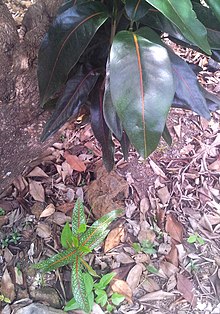

Heteroblasty is the significant and abrupt change in form and function, that occurs over the lifespan of certain plants. Characteristics affected include internode length and stem structure as well as leaf form, size and arrangement.[1] It should not be confused with seasonal heterophylly, where early and late growth in a season are visibly different.[2] This change is different from a homoblastic change which is a gradual change or little change at all, so that there is little difference between the juvenile and adult stages.[3] Some characteristics affected by heteroblastic change include the distance between successive leaves (internode length) and stem structure as well as leaf form, size and arrangement.[1] Heteroblasty is found in many plant families as well as only some species within a genus. This random spread of heteroblastic plants across species is believed to be caused by convergent evolution.[4]
The earlier and later stages of development are commonly labeled as juvenile and adult respectively, particularly in relation to leaves.[5] Heteroblastic change is thus often referred to as ‘vegetative phase change’ (distinct from reproductive phase change) in the plant molecular biology literature.[6]
The term heteroblasty was coined by the German botanist Karl Ritter von Goebel, along with homoblasty for plants with leaf characteristics that do not change significantly. Leonard Cockayne observed that heteroblasty occurred in an unusually high proportion of tree species native to New Zealand.[7]
- ^ a b Cite error: The named reference
Zotz_2011was invoked but never defined (see the help page). - ^ Eckenwalder JE (1980). "Foliar Heteromorphism in Populus (Salicaceae), a Source of Confusion in the Taxonomy of Tertiary Leaf Remains". Systematic Botany. 5 (4): 366–383. doi:10.2307/2418518. JSTOR 2418518.
- ^ Gamage HK, Jesson L (2007). "Leaf heteroblasty is not an adaptation to shade: seedling anatomical and physiological responses to light". New Zealand Journal of Ecology. 31 (2): 245–254. JSTOR 24058149.
- ^ Day JS (1998). "Light Conditions and the Evolution of Heterblasty (and the Divaricate Form) In New Zealand". New Zealand Journal of Ecology. 22 (1): 43–54. JSTOR 24054547.
- ^ McCusker A. "Flora of Australia Glossary". Department of the Environment, Water, Heritage, and the Arts. Retrieved 23 December 2014.
- ^ Poethig, R. S. (2010). "The past, present, and future of vegetative phase change". Plant Physiology. 154 (2): 541–544. doi:10.1104/pp.110.161620. PMC 2949024. PMID 20921181.
- ^ Cockayne L (1912). "Observations concerning evolution, derived from ecological studies in New Zealand". Transactions and Proceedings of the New Zealand Institute. 44: 1–50.